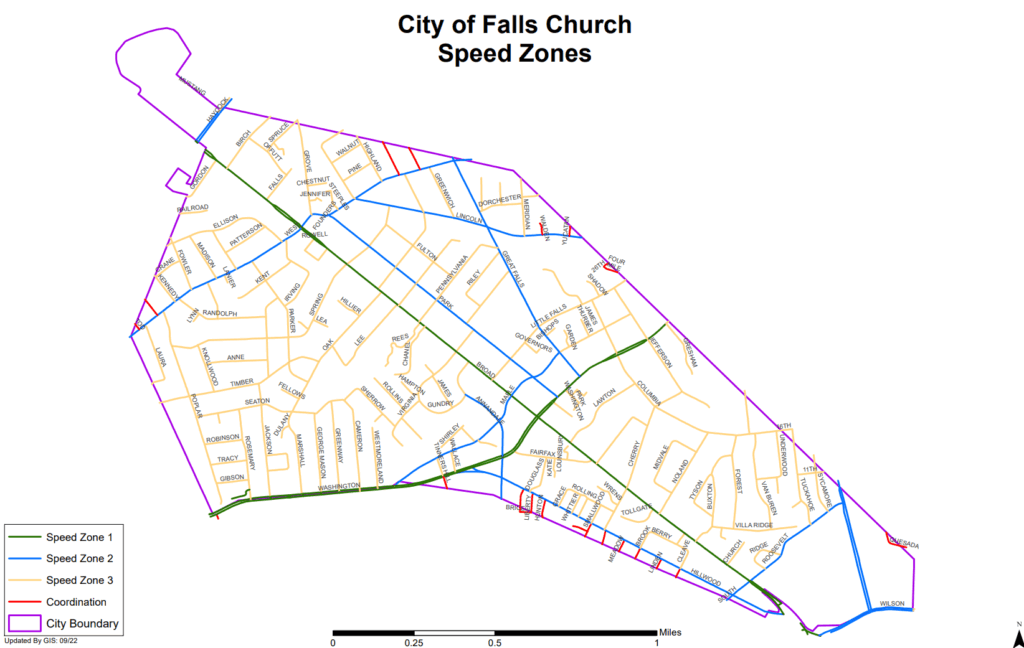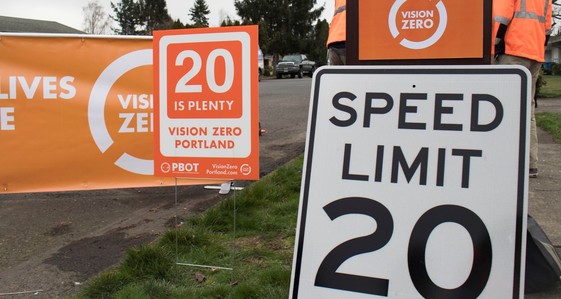Updates from Letty – September 23, 2022
Blog posts are the personal views of Letty Hardi and not official statements or records on behalf of the Falls Church City Council
Dear Friends,
Based on the questions and concerns I field regularly, our work session this week should rank among one of our most important: we covered all things transportation safety in a joint work session with our volunteer citizen transportation committee. I’ll also share how I’m thinking about equity in transportation, as part of our commitment to equity which should permeate our decision-making beyond lofty statements. I challenge all of us to think about transportation needs for households that may not look like our own, so I’ll link to the demographic data for Falls Church. Read on to learn more about the latest on:
(1) 20 mph speed limit proposal
(2) Neighborhood Traffic Calming program
(3) Quicker transportation improvement projects & maintenance issues
Due to Rosh Hashanah next week, we’ll be meeting on Tuesday night (where you can join in person or online to give public comment) followed by our “Meet the Council” in person office hours at City Hall on Wednesday morning.
Best,
Letty
What Happened This Week:
(1) 20 MPH Speed Limits
As one of several strategies to create safer streets (infrastructure, road design changes and enforcement are other strategies, for example) we are considering a reduction of speed limits from 25 mph to 20 mph on local residential streets. The data on the benefits of a 20 mph limit are compelling as cars become dramatically deadlier at speeds above 20 mph. Washington, DC and other cities have made this change the past few years.
Staff has broken up the streets in the city into 3 zones in the map below: arterial (green), collector (blue), and local streets (yellow). As the arterial and collector* streets would require a lot more engineering changes on the streets to encourage drivers to obey a lower speed limit, only the 3rd category of local streets is currently proposed to have the change in speed limits. If adopted, the cost is estimated around $100K for new signage and communication/education about the new speed limits. The chief of police joined us in the work session and reported that police is supportive and will be ready to enforce the new speed limits if adopted and the new speed limit signs are posted.
Next steps: we’ll have public hearings before an ordinance is up for a vote. If approved, there will be a comprehensive communication campaign to explain the changes and how they will improve safety, then new signs will need to be installed before the new speed limits are effective. So more to come – we’re happy to hear from you.
*We did discuss that after traffic calming projects on collector streets completed, those streets could have their speed limits lowered to 20 mph as well.
Letty’s thoughts: Reducing to 20 mph makes sense as long as it’s not the only strategy we use to improve safety on the street, and it’s not. While I personally believe physical infrastructure and street design are more important (ex: traffic calming tools like speed bumps, curb extensions, narrower streets, high visibility crosswalks, etc). We should use this new authority granted by the General Assembly. I also look forward to expanding automated enforcement with both red light and speed cameras which are both effective and deterrent. Alone, lower speed limits won’t solve the problem but they can be deployed as a part of a bigger mix of strategies.
(2) Neighborhood Traffic Calming
Neighborhood Traffic Calming is a program to improve pedestrian and cyclist safety based on resident-initiated requests. Usually after a request is started, data collection and analysis will occur to determine the best traffic calming solution which will then be voted on by the neighborhood. As there are usually more requests than budget allows, the Citizen Advisory Committee on Transportation (CACT) helps prioritize the projects. Over 10 projects were completed last year, such as the speed bumps, painted lines, and curb extension on S. Oak and S. Lee.
Staff reported on the status of various projects in process, including the Greenway Downs project which will be our largest NTC project to date, as it will include all of the streets off Rt 29 using federal grant dollars (whereas most NTC projects are locally funded).
Letty’s thoughts: NTC is an important, long standing program that has made important safety improvements on our streets. It’s a program we’ve consistently supported with additional budget dollars when available. As we continue our journey to pursue equity across all facets of local government, comments from several CACT members in our work session really resonated with me: we need to be thoughtful about where NTC improvements occur, starting with ensuring there is broad awareness and understanding of the program across the city so it’s not only the most affluent neighborhoods who are knowledgeable enough to bring cases forward. Also, we need to consider who gets a say in what our streets look like – if we believe that streets should be for everyone, we need to strike a balance between the improvements that will protect the most vulnerable using our streets (pedestrians and cyclists) and the concerns of the neighborhood. This is a good reminder of the demographics of the city that I’ve shared before – for example, as our population nears 15K and 6K households, you might be surprised that we actually have more multifamily housing units than single family homes and less than 30% of households have children. How do we ensure transportation infrastructure serves everyone, especially those who may not be a household that looks like your own?
Finally, for large scale NTC projects like Greenway Downs – where the intent of the project was to tackle all of the streets all at once to not create a “whack a mole” situation (ie, traffic diverts from one street to another) – we need to make sure individual street designs aren’t watered down so that the overall design still accomplishes the objective of reducing cut through traffic and speeding.
(3) Quicker Transportation Projects & Maintenance Issues
We’ve seen an increasing number of resident-requested safety improvements to our streets, especially post-Covid (likely a combination of more pedestrians enjoying the outdoors and drivers being more reckless). City Council has also asked for a more agile approach to both increase the responsiveness and throughput for delivering these smaller transportation improvements vs large capital projects. So this week, we reviewed a staff proposal on how we could fund a 5 person “strike team”, including an in house engineer, inspector, and small operations crew to fulfill small scale, lower cost transportation projects like painting, bollards, street signs and other tactical urbansim projects, for about $450K/year and $250K in equipment and maintenance cost.
Public Works also presented an alarming picture of the current state of our core transportation infrastructure, requesting an additional $3-5M/year for maintenance needs, especially in the areas of paving, bridges, and signal maintenance. The staff report includes more details and photos of the especially concerning areas of deferred maintenance. (To allay some immediate concerns: the S. Oak bridge identified in the report is scheduled for a full replacement in Spring 2023 and the Sherrow Bridge just secured funding for a replacement, so those needs will be addressed.)
Letty’s thoughts: there was a universally enthusiastic response to the “quick hits” approach for small transportation safety improvements. I’ve been a long time fan of trying out low cost, interim ideas that can make improvements instead of waiting for full scale, complex engineering solutions that may take years. In October, I expect we’ll consider a budget amendment to fund this new team and approach so they can begin tackling the long queue of work. As for the infrastructure maintenance concerns – we were all surprised to receive such news. In my past seven budgets on City Council, we haven’t been presented these critical issues with the exception of paving, where we did allocate additional funds in the most recent FY23 budget cycle. I’ll be following up to understand the root causes of why we’ve underfunded these maintenance areas and a plan to ramp up our budgets to take care of these needs, where I’d prioritize the items that most impact safety.
Not discussed this week, but also are key parts of our transportation safety focus are initiatives like the sidewalk program where we’re slowly connecting “missing link” sidewalks and specific projects like HAWK signals at Berry, Fairfax, and Oak, a new full movement intersection and crosswalks at S. Maple/S. Washington, improvements at Haycock/Rt 7. Transportation projects are one of the biggest areas of investment for us as we evolve from a car-dependent suburb to a more walkable, bikeable community.
What’s Coming Up:
Tuesday, September 27 – City Council Meeting* (moved to Tuesday due to Rosh Hashanah)
Wednesday, September 28 – Meet the Council Office Hours (City Hall, 9 am)
Thursday, September 29 – League of Women Voters City Five Year Outlook Forum
Tuesday, October 11 – Bus Rapid Transit (BRT) Community Chat (Meridian HS, 630-8 pm)
Tuesday, October 11 – City Council Meeting* (moved to Tuesday due to Indigenous Peoples Day)
*every Monday (except 5th Mondays and holidays) at 7:30 pm. You can access the agenda and livestream here, including recordings of past meetings